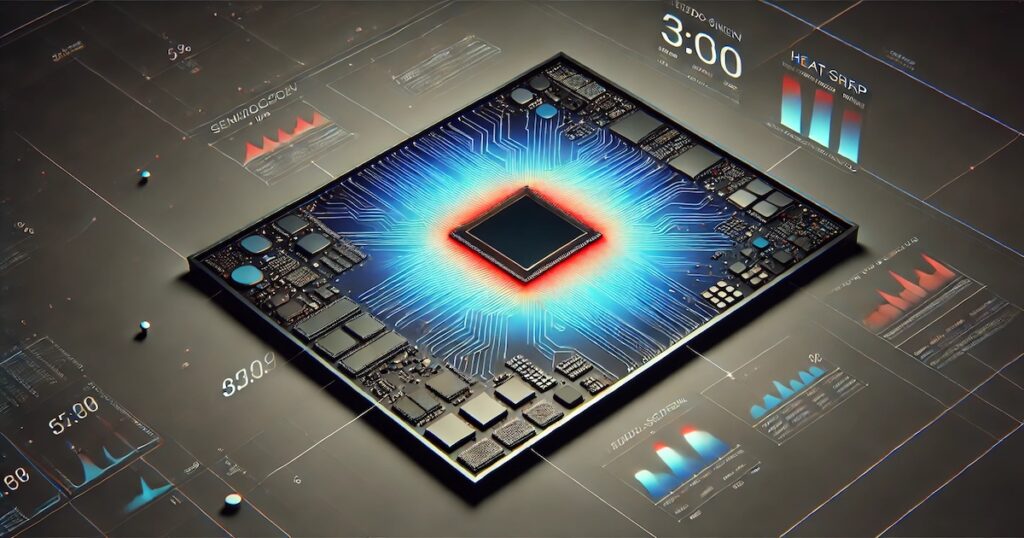Image Generated Using DALL-E
The Role Of AI In Key Areas Of Chip Design
The increasing complexity of semiconductor chips, with billions of transistors densely packed, poses challenges in performance, efficiency, and design time. AI is now a powerful assistive tool, automating many aspects of chip design. In placement optimization, AI models like those used by Google’s TPU design leverage reinforcement learning to place components faster and more efficiently.
AI tools like MaskPlace ensure optimal configurations, allowing engineers to focus on higher-level tasks. Similarly, routing – where signal paths are established – benefits from AI models like those used by NVIDIA, balancing signal performance and thermal management. AI’s influence extends into logic synthesis, where models like DRiLLS use deep reinforcement learning to automate hardware logic mapping.
By significantly reducing the need for manual fine-tuning, AI accelerates the design process and enhances accuracy. AI-driven tools in PPA prediction (Power, Performance, and Area) further support engineers by predicting congestion, timing delays, and design bottlenecks. Models like CongestionNet leverage graph neural networks (GNNs) to identify issues early, enabling better design decisions before chips are manufactured, and reducing costly errors later in the cycle.
AI in chip design does not replace human expertise but complements it. By automating repetitive, data-heavy tasks, AI frees engineers to focus on innovative problem-solving. These tools enhance chip design speed, accuracy, and scalability, empowering engineers to push the boundaries of semiconductor technology.
Adoption Race And Struggle
The race to adopt AI-driven chip design tools is intensifying as semiconductor companies aim to enhance productivity and stay competitive. More prominent players like Google and NVIDIA have already integrated AI into their design pipelines, seeing tangible improvements in speed and efficiency. However, smaller firms face challenges in AI adoption due to the high costs of implementing these advanced models and the need for more specialized talent.
| Challenge | Description |
|---|---|
| Adoption Race | Larger companies like Google and NVIDIA have already adopted AI, gaining a competitive edge, while smaller firms struggle due to high costs and talent scarcity. |
| Data Dependency And Bias Concerns | AI models depend on large amounts of high-quality data. Data scarcity and model bias can lead to suboptimal designs or overlook innovative solutions. |
| Verification And Trust Issues | AI’s black-box nature leads to concerns about verification. Human oversight is often needed to ensure AI-generated designs meet functional and manufacturing requirements. |
| Talent And Expertise Gap | A shortage of engineers with both chip design and AI expertise is slowing AI adoption. Smaller companies struggle more, widening the gap between them and larger competitors. |
Another obstacle is the learning curve for integrating AI into existing workflows. Many engineers, who have long relied on traditional design methods, must now adapt to AI-enhanced systems, which necessitates retraining and a shift in design culture. However, concerns about the opaque nature of AI algorithms can create hesitation, as engineers and decision-makers require transparency in the models to comprehend the rationale behind decisions like placement or routing.
Despite these challenges, the potential gains in reducing design times, optimizing power and performance, and catching errors early have pushed companies to embrace AI. The race is about who can integrate AI faster and more effectively, but those who lag may struggle with inefficiency and rising costs in increasingly competitive markets.

State Of AI Research For Chip Design
As the complexity of semiconductor design continues to grow, the need for innovative tools that assist engineers has become critical. Large Language Models (LLMs) are emerging as game-changers in Electronic Design Automation (EDA), offering powerful capabilities to automate tasks, generate HDL code, and enhance the chip design process. These LLM-driven tools enable engineers to tackle complex design problems more efficiently, whether automating RTL generation, optimizing PPA, or enhancing verification processes.
Table below shows a summary of some of the most promising AI and LLM-based tools, platforms, and research initiatives driving the future of chip design.
| Research | Description |
|---|---|
| Assistant Chatbot | Users interact with LLMs for knowledge acquisition and Q&A, enhancing interaction with EDA software. |
| ChipNeMo | Domain-adapted LLM for Chip Design; new interaction paradigm for complex EDA software leveraging GPT. |
| RapidGPT | Ultimate HDL Pair-Designer, assisting in HDL design. |
| EDA Corpus | Dataset for enhanced interaction with OpenROAD. |
| HDL and Script Generation | LLMs generate RTL codes and EDA controlling scripts, with a focus on evaluating code quality (syntax correctness, PPA, security). |
| ChatEDA | LLM-powered autonomous agent for EDA. |
| ChipGPT | Explores natural language hardware design with LLMs. |
| CodeGen | Open-source LLM for code with multi-turn program synthesis. |
| RTLLM | Open-source benchmark for RTL code generation with LLM. |
| GPT4AIGChip | AI-driven accelerator design automation via LLM. |
| AutoChip | Automating HDL generation with LLM feedback. |
| Chip-Chat | Challenges and opportunities in conversational hardware design. |
| VeriGen | LLM for Verilog code generation. |
| Secure Hardware Generation | Generating secure hardware using LLMs resistant to CWEs. |
| AI for Wireless Systems | LLM power applied to wireless system development on FPGA platforms. |
| Verilog Autocompletion | AI-driven Verilog autocompletion for design and verification automation. |
| RTLCoder | RTL code generation outperforming GPT-3.5 using open-source datasets. |
| VerilogEval | Evaluating LLMs for Verilog RTL code generation. |
| SpecLLM | Exploring LLM use for VLSI design specifications. |
| Zero-Shot RTL Code Generation | Attention Sink augmented LLMs for zero-shot RTL code generation. |
| CreativEval | Evaluating LLM creativity in hardware code generation. |
| Evaluating LLMs | LLM evaluation for hardware design and test. |
| AnalogCoder | Analog circuit design via training-free code generation. |
| Data-Augmentation for Chip Design | AI design-data augmentation framework for chip design. |
| SynthAI | Generative AI for modular HLS design generation. |
| LLM-Aided Testbench Generation | LLM-aided testbench generation and bug detection for finite-state machines. |
| Code Analysis and Verification | LLMs for wide application in code analysis (bug detection, summarization, security checking). |
| LLM4SecHW | LLM for hardware debugging and SoC security verification. |
| RTLFixer | Fixing RTL syntax errors using LLMs. |
| DIVAS | LLM-based end-to-end framework for SoC security analysis and protection. |
| LLM for SoC Security | Hardware security bugs fixed using LLMs. |
| Deep Learning for Verilog | Deep learning framework for Verilog autocompletion towards design verification automation. |
| AssertLLM | Generates hardware verification assertions from design specs. |
| Self-HWDebug | Automation of LLM self-instructing for hardware security verification. |
| Large Circuit Models (LCMs) | Multimodal circuit representation learning for functional specifications, netlists, and layouts. |
| LLMs as Agent | LLMs act as agents for task planning and execution to refine design outcomes. |
| ChatPattern | LLM for layout pattern customization using natural language. |
| Standard Cell Layout Design | LLM for standard cell layout design optimization. |
| LayoutCopilot | Multi-agent collaborative framework for analog layout design. |
Adopting AI and LLMs in EDA will usher a new era of semiconductor design, where automation and intelligent agents work hand-in-hand with human expertise. These tools accelerate the design process, reduce errors, and optimize performance across the entire chip lifecycle. As computing industry continue to push the limits of technology, these AI-driven innovations will play a crucial role in transforming the semiconductor industry, making chip design more accessible, efficient, and scalable than ever before.
Challenges And Future Directions
AI models heavily depend on large, high-quality datasets to perform effectively in chip design. However, obtaining labeled data specific to semiconductor design is difficult, and bias in training data can lead to suboptimal designs, especially in cases with unique requirements. To proactively mitigate this, it is essential to diversify training datasets, ensuring AI models generalize well across a broader range of scenarios and improve chip design quality.
One of the primary concerns with AI in chip design is the black-box nature of some models. While AI can optimize performance and power, engineers play a crucial role in verifying the rationale behind AI-generated designs. This active involvement is essential to address trust issues arising from the lack of transparency, and it also ensures the adoption of AI in critical design workflows is not hindered.
Although AI has excelled in tasks like placement and routing, scaling these models to handle diverse chip architectures, including analog and mixed-signal designs, remains challenging. Additionally, the limited talent pool with expertise in semiconductor design and AI further slows adoption. Addressing this skill gap is vital for the seamless integration of AI into chip design processes.
The future of AI in chip design lies in explainable AI (XAI), cross-domain collaboration, and adaptive models. XAI will help engineers understand AI decision-making processes, boosting trust and efficiency. Moreover, AI will increasingly augment EDA tools, enabling real-time optimization across the entire design lifecycle. Adaptive AI models will iteratively refine designs based on real-world performance, positioning AI as a true co-designer.






